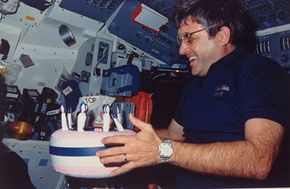Getting Food into Space
About a month before a mission launches, all food that will be taken aboard is packaged and stored in refrigerated lockers at the Johnson Space Center. Three weeks before launch, the food is transported to Kennedy Space Center in Florida. It's loaded onboard the shuttle two to three days before launch.
The space shuttle carries about 3.8 pounds of food, including 1 pound of packaging, per astronaut for each day of the mission. The astronauts get three meals a day, plus snacks. A back-up Safe Haven food system provides an extra 2,000 calories per day, per astronaut. It's designed to sustain the crew for an extra three weeks in case of emergency.
Advertisement
The meals are stored in locker trays, arranged in the order that the astronauts will eat them. Considering that a space mission can last months, foods in space need to be designed and packaged to prevent spoilage. Because the space shuttle doesn't have a refrigerator, foods must stay fresh at ambient temperatures. There are several ways space food can be prepared:
- Rehydratable (or freeze-dried) foods: Water is removed from the food during packaging. Soups, casseroles, scrambled eggs and breakfast cereals are all packaged this way.
- Intermediate moisture foods: Some water is removed from the food, but not all. Dried peaches, pears and apricots are examples of intermediate moisture foods.
- Thermostabilized foods: These foods are heat processed to destroy bacteria and other organisms so they can be stored at ambient temperature. Fruits and tuna fish are sometimes preserved by this method.
- Irradiated foods: Meats are cooked, packaged in foil pouches and briefly exposed to radiation from gamma rays or electron beams so they won't grow bacteria. The World Health Organization and American Medical Association say that irradiated foods are safe to eat.
- Natural form foods: Granola bars, nuts and cookies are examples of food with a naturally long shelf-life. Natural form foods are kept in ready-to-eat pouches.
- Fresh foods: Fruits and vegetables are usually packaged in plastic bags and sanitized in chlorine to preserve their freshness. But with no refrigeration onboard the shuttle, these foods must be eaten within the first two to three days of the mission or they'll spoil.
Food packaging is designed to be easy to use, small enough to dispose of in the onboard trash compactor and sturdy enough to keep food fresh for up to a year. Rehydratable foods are packaged in flexible bowls with lids. A fabric fastener locks the bottom of the bowl to the meal tray. Foods can also be kept in cans with pull-off lids, plastic cups or flexible pouches. Astronauts add water to rehydratable food bowls and drink pouches through a small opening called a septum adapter.
Condiments like ketchup, mustard and mayonnaise have their own packaging. Salt and pepper are stored in liquid form so that the crystals or granules don't float away. Salt is dissolved in water while pepper is suspended in oil.
The space shuttle gets its water supply from fuel cells, which produce electricity by combining hydrogen and oxygen -- the main components of water. At the International Space Station, water is recycled from the cabin air. Because there is little water to spare, most foods on the Space Station are thermostabilized rather than dehydrated.
But how do astronauts actually prepare a meal in microgravity? And what will astronauts be eating on future missions? Find out in the next section.
